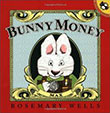Bunny Money Lesson for Grades K-1

Teach saving, spending, and productive resources using the book “Bunny Money.”
In this lesson, students listen to the story of Ruby and Max, two bunnies that go shopping and make many spending decisions. They are introduced to short-term and long-term savings goals to help them save for the goods they want in the future. After a goal-sorting activity, students choose and illustrate their own savings goal.
- Lesson (pdf)
- Google Classroom
- Whiteboard (SMART/notebook)
- Whiteboard (ActivInspire/flipchart)
- Supplemental Math Activity
- Q&A (pdf)
Objectives
Students will
- define goods, spending, saving, and interest;
- name two types of savings goals;
- give examples of short-term and long-term savings goals; and
- explain why a bank is a good place to save money.
This lesson plan is designed for teaching grades K and 1.
Book written by Rosemary Wells / ISBN: 978-0-14-056750-2. This book is in print and available.
Parents: Learn more about the Q&A using Bunny Money.
Common Core
Grades 1 and 2 English Language Arts Standards--Reading: Literature
- Key Ideas and Details
- RL.1.1, RL.2.1. Ask and answer such questions as who, what, where, when, why, and how to demonstrate understanding of key details in a text.
- RL.1.3, RL.2.3. Describe how characters in a story respond to major events and challenges.
- Integration of Knowledge and Ideas
- RL.1.7, RL.2.7. Use information gained from the illustrations and words in a print or digital text to demonstrate understanding of its characters, setting, or plot.
- Comprehension and Collaboration
- SL.1.2, SL.2.2. Recount or describe key ideas or details from a text read aloud or information presented orally or through other media.
Grades 1 and 2 Mathematics & Algebraic Thinking
- Add and subtract within 20.
- 1.OA.2, 2.OA.2. Fluently add and subtract within 20 using mental strategies. By end of Grade 2, know from memory all sums of two one-digit numbers.
- Understand and apply properties of operations and the relationship between addition and subtraction.
- 1.OA.4.Understand subtraction as an unknown-addend problem. For example, subtract 10 – 8 by finding the number that makes 10 when added to 8. Add and subtract within 20.
---
If you have difficulty accessing this content due to a disability, please contact us at economiceducation@stls.frb.org or call the St. Louis Fed at 314-444-8444 and ask for Economic Education.

